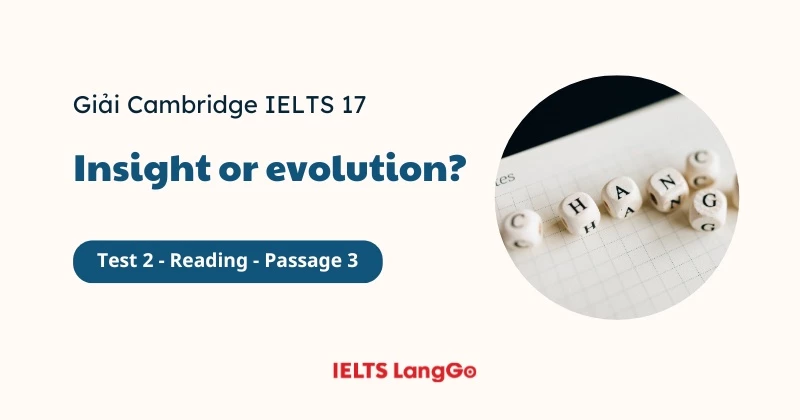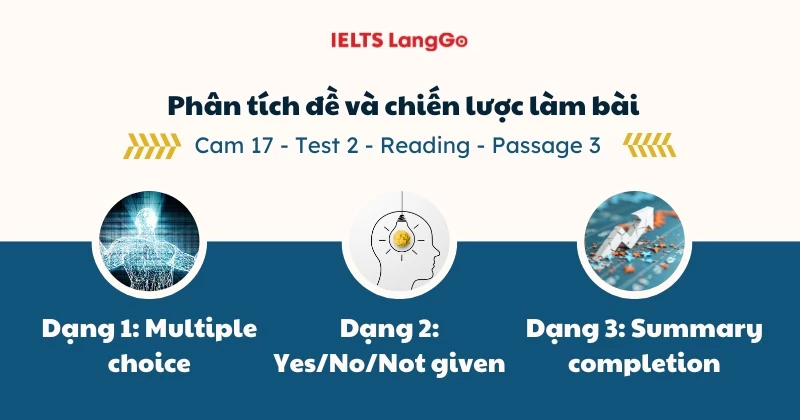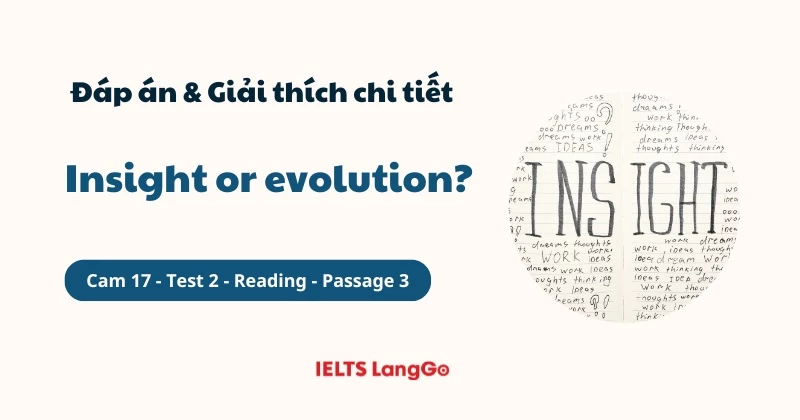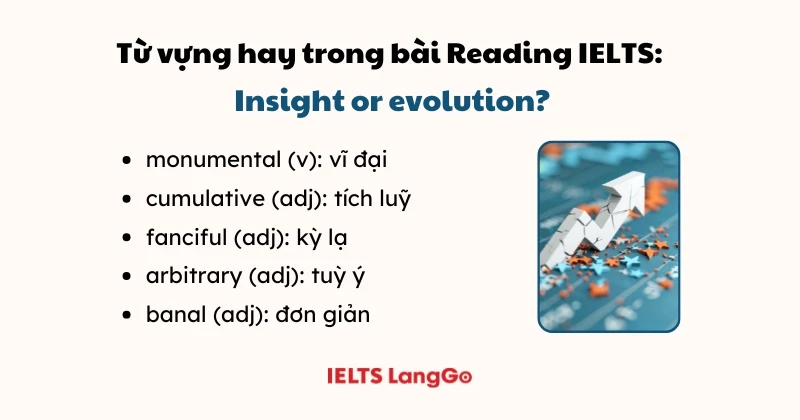



Trong bài viết sau, IELTS LangGo sẽ cung cấp cho các bạn đáp án và giải thích chi tiết của Cam 17, Test 2, Reading passage 3: Insight or evolution? cũng như một số tips các bạn có thể trau dồi để làm tốt hơn sau mỗi lần luyện đề nhé!
Đầu tiên chúng ta hãy cùng xem bài đọc cũng như các câu hỏi nhé:
Insight or evolution?
Two scientists consider the origins of discoveries and other innovative behavior
Scientific discovery is popularly believed to result from the sheer genius of such intellectual stars as naturalist Charles Darwin and theoretical physicist Albert Einstein. Our view of such unique contributions to science often disregards the person’s prior experience and the efforts of their lesser-known predecessors. Conventional wisdom also places great weight on insight in promoting breakthrough scientific achievements, as if ideas spontaneously pop into someone’s head – fully formed and functional.
Khám phá khoa học thường được tin rằng là kết quả của thiên tài thuần túy từ những ngôi sao trí tuệ như nhà tự nhiên học Charles Darwin và nhà vật lý lý thuyết Albert Einstein. Quan điểm của chúng ta về những đóng góp độc đáo như vậy thường bỏ qua kinh nghiệm trước đó của cá nhân và những nỗ lực của những người tiền nhiệm ít được biết đến hơn. Sự khôn ngoan truyền thống cũng đặt trọng tâm lớn vào sự sáng suốt trong việc thúc đẩy những đột phá khoa học, như thể các ý tưởng tự nhiên nảy ra trong đầu ai đó – một cách đầy đủ và hoàn thiện.
There may be some limited truth to this view. However, we believe that it largely misrepresents the real nature of scientific discovery, as well as that of creativity and innovation in many other realms of human endeavor.
Có thể có một phần sự thật hạn chế trong quan điểm này. Tuy nhiên, chúng tôi tin rằng điều đó phần lớn đã hiểu sai bản chất thực sự của khám phá khoa học, cũng như của sự sáng tạo và đổi mới trong nhiều lĩnh vực khác của nỗ lực con người.
Setting aside such greats as Darwin and Einstein – whose monumental contributions are duly celebrated – we suggest that innovation is more a process of trial and error, where two steps forward may sometimes come with one step back, as well as one or more steps to the right or left. This evolutionary view of human innovation undermines the notion of creative genius and recognizes the cumulative nature of scientific progress.
Bỏ qua những vĩ nhân như Darwin và Einstein – những người có đóng góp to lớn đã được công nhận – chúng tôi cho rằng đổi mới giống như một quá trình thử và sai, trong đó hai bước tiến về phía trước đôi khi đi kèm với một bước lùi, cũng như một hoặc nhiều bước sang trái hoặc phải. Quan điểm tiến hóa này về đổi mới của con người làm suy yếu khái niệm thiên tài sáng tạo và công nhận bản chất tích lũy của tiến bộ khoa học.
Consider one unheralded scientist: John Nicholson, a mathematical physicist working in the 1910s who postulated the existence of ‘proto-elements’ in outer space. By combining different numbers of weights of these proto-elements’ atoms, Nicholson could recover the weights of all the elements in the then-known periodic table. These successes are all the more noteworthy given the fact that Nicholson was wrong about the presence of proto-elements: they do not actually exist. Yet, amid his often fanciful theories and wild speculations, Nicholson also proposed a novel theory about the structure of atoms. Niels Bohr, the Nobel prize-winning father of modern atomic theory, jumped off from this interesting idea to conceive his now-famous model of the atom.
Hãy xem xét một nhà khoa học ít được biết đến: John Nicholson, một nhà vật lý toán học làm việc vào những năm 1910, người đã đưa ra giả thuyết về sự tồn tại của các ‘nguyên tố sơ khai’ trong không gian. Bằng cách kết hợp các số khối lượng khác nhau của nguyên tử các nguyên tố sơ khai này, Nicholson có thể xác định lại khối lượng của tất cả các nguyên tố trong bảng tuần hoàn được biết đến vào thời điểm đó. Những thành công này càng đáng chú ý hơn vì thực tế rằng Nicholson đã sai về sự tồn tại của các nguyên tố sơ khai – chúng thực tế không tồn tại. Tuy nhiên, giữa những lý thuyết kỳ lạ và suy đoán táo bạo của mình, Nicholson cũng đã đề xuất một lý thuyết mới về cấu trúc nguyên tử. Niels Bohr, cha đẻ của thuyết nguyên tử hiện đại và người từng đoạt giải Nobel, đã dựa trên ý tưởng thú vị này để hình thành mô hình nguyên tử nổi tiếng của mình.
What are we to make of this story? One might simply conclude that science is a collective and cumulative enterprise. That may be true, but there may be a deeper insight to be gleaned. We propose that science is constantly evolving, much as species of animals do. In biological systems, organisms may display new characteristics that result from random genetic mutations. In the same way, random, arbitrary or accidental mutations of ideas may help pave the way for advances in science. If mutations prove beneficial, then the animal or the scientific theory will continue to thrive and perhaps reproduce.
Chúng ta có thể rút ra điều gì từ câu chuyện này? Một người có thể đơn giản kết luận rằng khoa học là một quá trình tập thể và mang tính tích lũy. Điều đó có thể đúng, nhưng có thể có một hiểu biết sâu sắc hơn cần được khám phá. Chúng tôi đề xuất rằng khoa học không ngừng phát triển, giống như các loài động vật vậy. Trong hệ sinh học, sinh vật có thể biểu hiện những đặc điểm mới do đột biến gene ngẫu nhiên. Tương tự, những đột biến ngẫu nhiên, tùy ý hoặc tình cờ của ý tưởng có thể giúp mở đường cho những tiến bộ trong khoa học. Nếu những đột biến này mang lại lợi ích, thì loài động vật hoặc lý thuyết khoa học đó sẽ tiếp tục tồn tại và có thể được nhân rộng.
Support for this evolutionary view of behavioral innovation comes from many domains. Consider one example of an influential innovation in US horseracing. The so-called ‘acey-deucy’ stirrup placement, in which the rider’s foot in his left stirrup is placed as much as 25 centimeters lower than the right, is believed to confer important speed advantages when turning on oval tracks. It was developed by a relatively unknown jockey named Jackie Westrope. Had Westrope conducted methodical investigations or examined extensive film records in a shrewd plan to outrun his rivals? Had he foreseen the speed advantage that would be conferred by riding acey-deucy? No. He suffered a leg injury, which left him unable to fully bend his left knee. His modification just happened to coincide with enhanced left-hand turning performance. This led to the rapid and widespread adoption of riding acey-deucy by many riders, a racing style which continues in today’s thoroughbred racing.
Sự ủng hộ cho quan điểm tiến hóa về đổi mới hành vi này đến từ nhiều lĩnh vực khác nhau. Hãy xem xét một ví dụ về một đổi mới có ảnh hưởng trong đua ngựa ở Mỹ. Cách đặt bàn đạp ‘acey-deucy’, trong đó bàn chân của người cưỡi ngựa trong bàn đạp bên trái được đặt thấp hơn bàn chân bên phải tới 25 cm, được cho là mang lại lợi thế tốc độ quan trọng khi quay vòng trên đường đua hình bầu dục. Cách này được phát triển bởi một tay đua ít được biết đến tên là Jackie Westrope. Liệu Westrope có tiến hành điều tra có phương pháp hoặc xem xét kỹ lưỡng các đoạn phim để tìm ra cách vượt qua đối thủ không? Liệu anh ta có lường trước được lợi thế tốc độ mà cách cưỡi acey-deucy mang lại không? Không. Anh ta bị chấn thương ở chân, khiến anh ta không thể gập đầu gối trái hoàn toàn. Sự điều chỉnh này vô tình trùng hợp với việc cải thiện hiệu suất khi rẽ trái. Điều này dẫn đến việc cách cưỡi acey-deucy nhanh chóng được nhiều tay đua áp dụng rộng rãi, một phong cách đua vẫn còn tồn tại trong các cuộc đua ngựa thuần chủng ngày nay.
Plenty of other stories show that fresh advances can arise from error, misadventure, and also pure serendipity – a happy accident. For example, in the early 1970s, two employees of the company 3M each had a problem: Spencer Silver had a product – a glue which was only slightly sticky – and no use for it, while his colleague Art Fry was trying to figure out how to affix temporary bookmarks in his hymn book without damaging its pages. The solution to both these problems was the invention of the brilliantly simple yet phenomenally successful Post-It note. Such examples give lie to the claim that ingenious, designing minds are responsible for human creativity and invention. Far more banal and mechanical forces may be at work; forces that are fundamentally connected to the laws of science.
Có rất nhiều câu chuyện khác cho thấy những tiến bộ mới có thể xuất phát từ sai lầm, sự cố ngoài ý muốn và cả sự tình cờ may mắn. Ví dụ, vào đầu những năm 1970, hai nhân viên của công ty 3M đều gặp vấn đề: Spencer Silver có một sản phẩm – một loại keo chỉ hơi dính – nhưng không có ứng dụng cụ thể, trong khi đồng nghiệp của ông, Art Fry, đang cố gắng tìm cách gắn các dấu trang tạm thời vào cuốn sách thánh ca của mình mà không làm hỏng các trang sách. Giải pháp cho cả hai vấn đề này chính là phát minh đơn giản nhưng cực kỳ thành công: giấy ghi chú Post-It. Những ví dụ như vậy bác bỏ quan điểm rằng tư duy thiên tài là nguồn gốc của sự sáng tạo và phát minh của con người. Thực tế có thể là những cơ chế đơn giản và mang tính máy móc hơn nhiều đang hoạt động – những cơ chế có liên hệ chặt chẽ với các quy luật khoa học.
The notions of insight, creativity and genius are often invoked, but they remain vague and of doubtful scientific utility, especially when one considers the diverse and enduring contributions of individuals such as Plato, Leonardo da Vinci, Shakespeare, Beethoven, Galileo, Newton, Kepler, Curie, Pasteur and Edison. These notions merely label rather than explain the evolution of human innovations. We need another approach, and there is a promising candidate.
Những khái niệm về sự sáng suốt, sáng tạo và thiên tài thường được đề cập đến, nhưng chúng vẫn còn mơ hồ và có giá trị khoa học đáng nghi ngờ, đặc biệt khi xem xét những đóng góp đa dạng và lâu dài của những cá nhân như Plato, Leonardo da Vinci, Shakespeare, Beethoven, Galileo, Newton, Kepler, Curie, Pasteur và Edison. Những khái niệm này chỉ đơn thuần là nhãn dán chứ không thực sự giải thích được sự tiến hóa của những đổi mới của con người. Chúng ta cần một cách tiếp cận khác, và có một ứng cử viên đầy hứa hẹn.
The Law of Effect was advanced by psychologist Edward Thorndike in 1898, some 40 years after Charles Darwin published his groundbreaking work on biological evolution, On the Origin of Species. This simple law holds that organisms tend to repeat successful behaviors and to refrain from performing unsuccessful ones. Just like Darwin’s Law of Natural Selection, the Law of Effect involves an entirely mechanical process of variation and selection, without any end objective in sight.
Định luật Hiệu ứng được nhà tâm lý học Edward Thorndike đưa ra vào năm 1898, khoảng 40 năm sau khi Charles Darwin công bố công trình đột phá về tiến hóa sinh học, Nguồn gốc các loài. Định luật đơn giản này cho rằng sinh vật có xu hướng lặp lại những hành vi thành công và tránh thực hiện những hành vi không thành công. Giống như Định luật Chọn lọc Tự nhiên của Darwin, Định luật Hiệu ứng liên quan đến một quá trình hoàn toàn mang tính máy móc của sự biến đổi và chọn lọc, không có mục tiêu cuối cùng nào được định trước.
Of course, the origin of human innovation demands much further study. In particular, the provenance of the raw material on which the Law of Effect operates is not as clearly known as that of the genetic mutations on which the Law of Natural Selection operates. The generation of novel ideas and behaviors may not be entirely random, but constrained by prior successes and failures – of the current individual (such as Bohr) or of predecessors (such as Nicholson).
Tất nhiên, nguồn gốc của đổi mới của con người vẫn cần được nghiên cứu thêm. Đặc biệt, nguồn gốc của những yếu tố đầu vào mà Định luật Hiệu ứng hoạt động chưa rõ ràng như những đột biến gene mà Định luật Chọn lọc Tự nhiên dựa vào. Việc tạo ra những ý tưởng và hành vi mới có thể không hoàn toàn ngẫu nhiên, mà bị ràng buộc bởi những thành công và thất bại trước đó – của cá nhân hiện tại (như Bohr) hoặc của những người tiền nhiệm (như Nicholson).
The time seems right for abandoning the naive notions of intelligent design and genius, and for scientifically exploring the true origins of creative behavior.
Đã đến lúc từ bỏ những quan niệm ngây thơ về thiết kế thông minh và thiên tài, để khám phá một cách khoa học về nguồn gốc thực sự của hành vi sáng tạo.
Questions 27-31
Choose the correct letter, A, B, C, or D.
Write the correct letter in boxes 27-31.
27. The purpose of the first paragraph is to
defend particular ideas.
compare certain beliefs.
disprove a widely held view.
outline a common assumption.
28. What are the writers doing in the second paragraph?
criticising an opinion
justifying a standpoint
explaining an approach
supporting an argument
29. In the third paragraph, what do the writers suggest about Darwin and Einstein?
They represent an exception to a general rule.
Their way of working has been misunderstood.
They are an ideal which others should aspire to.
Their achievements deserve greater recognition.
30. John Nicholson is an example of a person whose idea
established his reputation as an influential scientist.
was only fully understood at a later point in history.
laid the foundations for someone else’s breakthrough.
initially met with scepticism from the scientific community.
31. What is the key point of interest about the ‘acey-deucy’ stirrup placement?
the simple reason why it was invented
the enthusiasm with which it was adopted
the research that went into its development
the cleverness of the person who first used it
Questions 32-36
Do the following statements agree with the claims of the writer in Reading Passage 3?
In boxes 32-36, write
YES if the statement agrees with the claims of the writer
NO if the statement contradicts the claims of the writer
NOT GIVEN if it is impossible to say what the writer thinks about this
32. Acknowledging people such as Plato or da Vinci á geniuses will help us understand the process by which great minds create new ideas.
33. The Law of Effect was discovered at a time when psychologists were seeking a scientific reason why creativity occurs.
34. The Law of Effect states that no planning is involved in the behaviour of organisms.
35. The Law of Effect sets out clear explanations about the sources of new ideas and behaviours.
36. Many scientists are now turning away from the notion of intelligent design and genius.
Questions 37-40
Complete the summary using the list of words, A-G, below.
Write the correct letter, A-G, in boxes 37-40.
A. invention
B. goals
C. compromise
D. mistakes
E. luck
F. inspiration
G. experiments
| The origin of creative behaviour The traditional view of scientific discovery is that breakthroughs happen when a single great mind has sudden 37 _____. Although this can occur, it is not often the case. Advances are more likely to be the result of a longer process. In some cases, this process involves 38 _____, such as Nicholson’s theory about proto-elements. In others, simple necessity may provoke innovation, as with Westrope’s decision to modify the position of his riding stirrups. There is also often an element of 39 _____, for example, the coincidence of ideas that led to the invention of the Post-It note. With both the Law of Natural Selection and the Law of Effect, there may be no clear 40 _____ involved, but merely a process of variation and selection. |
Phân tích đề và chiến lược làm bài:

Ở Passage này có 3 dạng câu hỏi chia thành 14 câu hỏi. Hãy cùng phân tích chiến lược làm bài của các dạng câu hỏi này nhé:
Dạng 1: Multiple choice
Dạng 2: Yes/No/Not given
Dạng 3: Summary completion
Đây là đáp án của các câu hỏi trong passage này:
| Answer | |
| 27. D | 34. YES |
| 28. A | 35. NO |
| 29. A | 36. NOT GIVEN |
| 30. C | 37. F |
| 31. A | 38. D |
| 32. NO | 39. E |
| 33. NOT GIVEN | 40. B |
Hãy đọc kỹ phần giải thích dưới đây để học thêm cả những cách đề bài paraphrase thông tin quan trọng nữa nhé. Dần dần các bạn sẽ phát hiện các từ đồng nghĩa, trái nghĩa hay cách diễn đạt khác tốt hơn và cải thiện tốc độ làm bài đấy.
Đáp án: D
Vị trí: Đoạn 1
Keywords câu hỏi:
27. The purpose of the first paragraph is to
defend particular ideas.
compare certain beliefs.
disprove a widely held view.
outline a common assumption.
Keywords trong bài đọc: Scientific discovery is popularly believed to result from the sheer genius of such intellectual stars as naturalist Charles Darwin and theoretical physicist Albert Einstein. Our view of such unique contributions to science often disregards the person’s prior experience and the efforts of their lesser-known predecessors. Conventional wisdom also places great weight on insight in promoting breakthrough scientific achievements, as if ideas spontaneously pop into someone’s head – fully formed and functional.
Giải thích:
Đáp án A nói rằng tác giả bảo vệ những ý kiến cụ thể tuy nhiên trong bài không hề nói về việc tác giả bảo vệ bất kỳ quan điểm nào -> Loại
Đáp án B nói rằng tác giả so sánh các niềm tin với nhau nhưng trong bài không có thông tin này -> Loại
Đáp án C nói rằng tác giả phản đối một quan điểm phổ biến rộng rãi nhưng trong bài không có thông tin này -> Loại
Đáp án D nói rằng tác giả chỉ ra một nhận định phổ biến mà trong đoạn 1 tác giả đưa ra một nhận định, niềm tin phổ biến rằng những phát minh khoa học là kết quả của sự thiên tài -> Chọn
Đáp án: A
Vị trí: Đoạn 2
Keywords câu hỏi:
28. What are the writers doing in the second paragraph?
criticising an opinion
justifying a standpoint
explaining an approach
supporting an argument
Keywords trong bài đọc: There may be some limited truth to this view. However, we believe that it largely misrepresents the real nature of scientific discovery, as well as that of creativity and innovation in many other realms of human endeavor.
Giải thích:
Đáp án A nói rằng tác giả đang phê phán một quan điểm mà trong bài có nói tác giả tin rằng quan điểm đã bóp méo bản chất của sự khám phá trong khoa học -> Chọn
Đáp án B nói rằng tác giả bào chữa cho một luận điểm nhưng trong bài tác giả đang chỉ trích luận điểm đó -> Loại
Đáp án C nói rằng tác giả đang giải thích một phương pháp, một cách tiếp cận nhưng trong bài không có thông tin này -> Loại
Đáp án D nói rằng tác giả đang ủng hộ cho một quan điểm nhưng trong bài không có thông tin này -> Loại
Đáp án: A
Vị trí: Đoạn 3
Keywords câu hỏi:
29. In the third paragraph, what do the writers suggest about Darwin and Einstein?
A. They represent an exception to a general rule.
B. Their way of working has been misunderstood.
C. They are an ideal which others should aspire to.
D. Their achievements deserve greater recognition.
Keywords trong bài đọc: Setting aside such greats as Darwin and Einstein – whose monumental contributions are duly celebrated – we suggest that innovation is more a process of trial and error, …
Giải thích:
Đáp án A nói rằng Darwin và Einstein là ngoại lệ cho một quy định chung mà trong bài lại nói với những nhân vật vĩ đại Như Darwin và Einstein thì việc sáng tạo là quá trình của thử nghiệm và sai lầm, và họ là những ngoại lệ -> Chọn
Đáp án B nói rằng các họ làm việc thường bị hiểu nhầm nhưng trong bài không có thông tin này -> Loại
Đáp án C nói rằng họ là những tấm gương mà mọi người nên học theo nhưng trong bài không có thông tin nào về việc mọi người nên học theo và cố gắng trở nên giống họ -> Loại
Đáp án D nói rằng những thành tựu của họ xứng đáng được công nhận hơn nhưng trong bài nói rằng những đóng góp to lớn của họ đã được ghi nhận một cách xứng đáng -> Loại
Đáp án: C
Vị trí: Đoạn 4
Keywords câu hỏi:
30. John Nicholson is an example of a person whose idea
A. established his reputation as an influential scientist.
B. was only fully understood at a later point in history.
C. laid the foundations for someone else’s breakthrough.
D. initially met with scepticism from the scientific community.
Keywords trong bài đọc: [...] Nicholson also proposed a novel theory about the structure of atoms. Niels Bohr, the Nobel prize-winning father of modern atomic theory, jumped off from this interesting idea to conceive his now-famous model of the atom.
Giải thích:
Đáp án A nói rằng John đã xây dựng sự nổi tiếng của mình với tư cách là một nhà khoa học có sức ảnh hưởng nhưng trong bài lại nói ông là một nhà khoa học ít được biết đến -> Loại
Đáp án B nói rằng ý tưởng của John chỉ hoàn toàn được hiểu ở phần sau của lịch sử nhưng trong bài không có thông tin nào như vậy -> Loại
Đáp án C nói rằng ý tưởng của John đã đặt nền móng cho thành tựu của người khác mà trong bài nói rằng Nicholson đề xuất giả thuyết mới về cấu trúc nguyên tử và Niels Bohr đã tạo ra mô hình nguyên tử nổi tiếng ngày nay nhờ vào ý tưởng đó -> Chọn
Đáp án D nói rằng ý tưởng của John lúc đầu đã gặp phải sự nghi ngờ từ cộng đồng khoa học nhưng trong bài không nhắc đến -> Loại

Đáp án: A
Vị trí: Đoạn 5
Keywords câu hỏi:
31. What is the key point of interest about the ‘acey-deucy’ stirrup placement?
A. the simple reason why it was invented
B. the enthusiasm with which it was adopted
C. the research that went into its development
D. the cleverness of the person who first used it
Keywords trong bài đọc: He suffered a leg injury, which left him unable to fully bend his left knee. His modification just happened to coincide with enhanced left-hand turning performance. This led to the rapid and widespread adoption of riding acey-deucy by many riders, a racing style which continues in today’s thoroughbred racing.
Giải thích:
Đáp án A nói rằng điểm thú vị chính là lý do đơn giản tại sao cách đua ngựa này lại được phát minh mà trong bài nói rằng Westrope phát minh ra nó vì anh ấy bị chấn thương ở chân và phải bắt buộc đưa ra thay đổi -> Chọn
Đáp án B nói rằng điểm thú vị là sự nhiệt tình mà nó được đón nhận nhưng đây không phải là điểm thú vị chính của kỹ thuật này -> Loại
Đáp án C nói rằng điểm thú vị là những nghiên cứu khi phát triển kỹ thuật này nhưng Westrope không có nghiên cứu gì cả -> Loại
Đáp án D nói rằng điểm thú vị là sự thông minh của người phát minh ra nó nhưng trong bài không nhắc đến thông tin này -> Loại
Đáp án: NO
Vị trí: Đoạn 8
Keywords câu hỏi: Acknowledging people such as Plato or da Vinci as geniuses will help us understand the process by which great minds create new ideas.
Keywords trong bài đọc: The notions of insight, creativity and genius are often invoked, but they remain vague and of doubtful scientific utility, especially when one considers the diverse and enduring contributions of individuals such as Plato, Leonardo da Vinci, Shakespeare, Beethoven, Galileo, Newton, Kepler, Curie, Pasteur and Edison. These notions merely label rather than explain the evolution of human innovations. We need another approach, and there is a promising candidate.
Giải thích: Trong câu hỏi nói rằng việc coi những người như Plato hay da Vinci là thiên tài sẽ giúp chúng ta hiểu quá trình những bộ óc vĩ đại tạo ra ý tưởng mới nhưng trong bài lại nói những đóng góp này chỉ đơn thuần đại diện chứ không giải thích được sự phát triển của những phát minh của con người -> NO.
Đáp án: NOT GIVEN
Vị trí: Đoạn 9
Keywords câu hỏi: The Law of Effect was discovered at a time when psychologists were seeking a scientific reason why creativity occurs.
Keywords trong bài đọc: The Law of Effect was advanced by psychologist Edward Thorndike in 1898, some 40 years after Charles Darwin published his groundbreaking work on biological evolution, On the Origin of Species.
Giải thích: Trong câu hỏi nói rằng định luật hiệu ứng được khám phá vào thời điểm mà những nhà tâm lý học đang tìm kiếm lý do khoa học tại sao sự sáng tạo lại xảy ra mà trong bài không nhắc đến việc này -> NOT GIVEN.
Đáp án: YES
Vị trí: Đoạn 9
Keywords câu hỏi: The Law of Effect states that no planning is involved in the behaviour of organisms.
Keywords trong bài đọc: Just like Darwin’s Law of Natural Selection, the Law of Effect involves an entirely mechanical process of variation and selection, without any end objective in sight.
Giải thích: Trong câu hỏi nói rằng định luật hiệu ứng nói rằng việc lên kế hoạch không liên quan đến hành vi của các sinh vật mà trong bài lại nói định luật hiệu ứng nói về quá trình của sự biến thể nhưng không có mục đích cụ thể nào -> YES.
Đáp án: NO
Vị trí: Đoạn 10
Keywords câu hỏi: The Law of Effect sets out clear explanations about the sources of new ideas and behaviours.
Keywords trong bài đọc: Of course, the origin of human innovation demands much further study.
Giải thích: Trong câu hỏi nói rằng định luật hiệu ứng đưa ra những lý giải rõ ràng về nguồn gốc của những ý tưởng và hành vi mới nhưng trong bài lại nói nguồn gốc của những phát minh của con người đòi hỏi nhiều nghiên cứu hơn -> NO.
Đáp án: NOT GIVEN
Vị trí: Đoạn 11
Keywords câu hỏi: Many scientists are now turning away from the notion of intelligent design and genius.
Keywords trong bài đọc: The time seems right for abandoning the naive notions of intelligent design and genius, and for scientifically exploring the true origins of creative behavior.
Giải thích: Trong câu hỏi nói rằng nhiều nhà khoa học bây giờ đang từ bỏ việc nghiên cứu về sự xuất chúng và thiên tài nhưng trong bài không có thông tin về việc này -> NOT GIVEN.
Đáp án: F
Vị trí: Đoạn 1
Keywords câu hỏi: The traditional view of scientific discovery is that breakthroughs happen when a single great mind has sudden 37 _____.
Keywords trong bài đọc: Conventional wisdom also places great weight on insight in promoting breakthrough scientific achievements, as if ideas spontaneously pop into someone’s head – fully formed and functional.
Giải thích: Trong câu hỏi nói rằng góc nhìn truyền thống về khám phá khoa học là những phát minh xảy ra khi một bộ óc vĩ đại có một cái gì đó bất ngờ, vậy ở đây từ cần điền sẽ đồng nghĩa với từ ideas trong bài nên ta chọn inspirations.
Đáp án: D
Vị trí: Đoạn 4
Keywords câu hỏi: In some cases, this process involves 38 _____, such as Nicholson’s theory about proto-elements.
Keywords trong bài đọc: Consider one unheralded scientist: John Nicholson, a mathematical physicist working in the 1910s who postulated the existence of ‘proto-elements’ in outer space. By combining different numbers of weights of these proto-elements’ atoms, Nicholson could recover the weights of all the elements in the then-known periodic table. These successes are all the more noteworthy given the fact that Nicholson was wrong about the presence of proto-elements: they do not actually exist.
Giải thích: Trong câu hỏi nói rằng ở vài trường hợp, quá trình này bao gồm điều gì đó, ví dụ như giả thuyết của Nicholson về proto nên từ cần điền sẽ đồng nghĩa với the fact that Nicholson was wrong và đó sẽ là mistakes.
Đáp án: E
Vị trí: Đoạn 7
Keywords câu hỏi: There is also often an element of 39 _____, for example, the coincidence of ideas that led to the invention of the Post-It note.
Keywords trong bài đọc: For example, in the early 1970s, two employees of the company 3M each had a problem: Spencer Silver had a product – a glue which was only slightly sticky – and no use for it, while his colleague Art Fry was trying to figure out how to affix temporary bookmarks in his hymn book without damaging its pages. The solution to both these problems was the invention of the brilliantly simple yet phenomenally successful Post-It note. Such examples give lie to the claim that ingenious, designing minds are responsible for human creativity and invention.
Giải thích: Trong câu hỏi nói rằng thường cũng có một yếu tố gì đó, ví dụ như sự tình cờ của các ý tưởng dẫn đến sự phát minh của ghi chú Post-It nên từ cần điền sẽ đồng nghĩa với Such examples give lie to the claim that ingenious, designing minds are responsible for human creativity and invention nên mình cần điền luck ở câu này.
Đáp án: B
Vị trí: Đoạn 7
Keywords câu hỏi: With both the Law of Natural Selection and the Law of Effect, there may be no clear 40 _____ involved, but merely a process of variation and selection.
Keywords trong bài đọc: Just like Darwin’s Law of Natural Selection, the Law of Effect involves an entirely mechanical process of variation and selection, without any end objective in sight.
Giải thích: Trong câu hỏi nói rằng với cả luật chọn lọc tự nhiên và luật hiệu ứng, không có điều gì đó rõ ràng mà chỉ là một quá trình của sự biến đổi và chọn lọc, nên ở đây từ cần điền sẽ đồng nghĩa với objective. Như vậy, goals là từ cần điền.
Sau khi đã chữa kỹ và hiểu tại sao mình lại sai thì bước tiếp theo các bạn nên làm là đọc lại bài và có thể tự tóm tắt nội dung của bài để chắc chắn là mình hiểu. Từ đây các bạn cũng có thể rút ra một số ý tưởng và từ vựng và cấu trúc ngữ pháp để áp dụng vào bài Writing hoặc Speaking của mình nhé.
IELTS LangGo sẽ giúp các bạn lọc ra một số từ vựng hữu ích từ bài đọc này:

lesser-known (adj): ít được biết đến
breakthrough achievement (n): thành tựu đột phá
pop into one’s head (phr.): nảy ra trong đầu ai
monumental (v): vĩ đại
cumulative (adj): tích luỹ
fanciful (adj): kỳ lạ
arbitrary (adj): tuỳ ý
pave the way for (phr.): mở đường cho
coincide with (phr.): trùng hợp với
banal (adj): đơn giản
groundbreaking (adj): đột phá
genetic mutation (n): đột biến gene
cognitive (adj): thuộc về nhận thích
place weight on (phr.): đặt sức nặng lên
endeavor (n): nỗ lực
set aside (phr.): đặt sang một bên
unheralded (adj): ít được biết đến
Trên đây là phần giải đề Cam 17, Test 2, Reading passage 3: Insight or evolution?. Hãy chú trọng vào việc chữa bài thật kỹ và hiểu sâu các vấn đề mình gặp phải khi làm sai hoặc phân vân bất kỳ một câu nào và cũng đừng quên học tập thêm các từ vựng hay, những cấu trúc ngữ pháp đặc sắc để tận dụng cho các phần thi khác của mình các bạn nhé!



ĐẶT LỊCH TƯ VẤN MIỄN PHÍ LỘ TRÌNH Săn ƯU ĐÃI lên tới 12.000.000đ